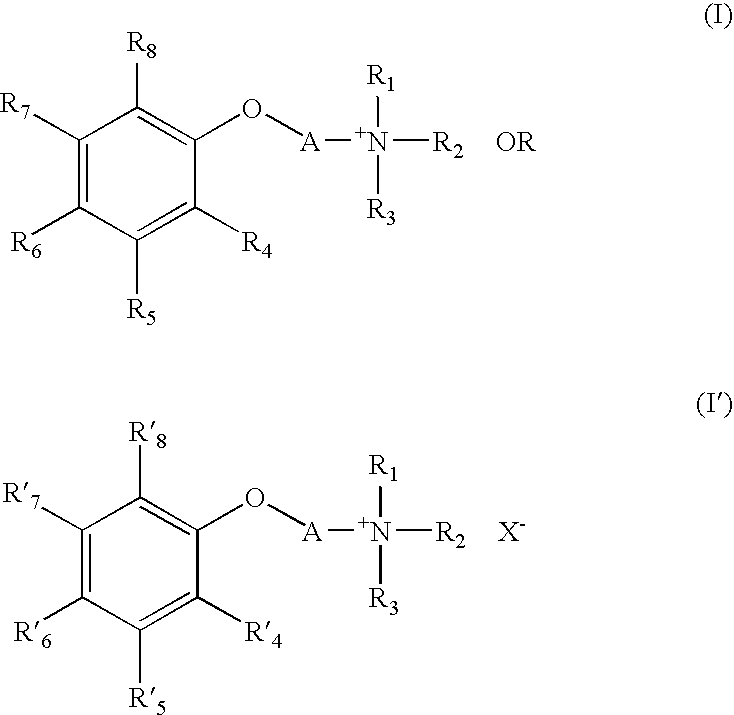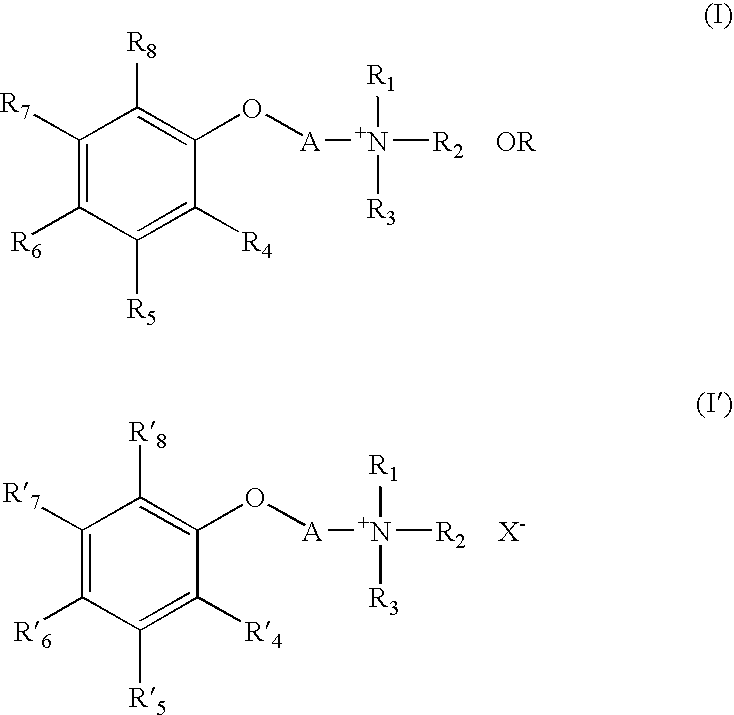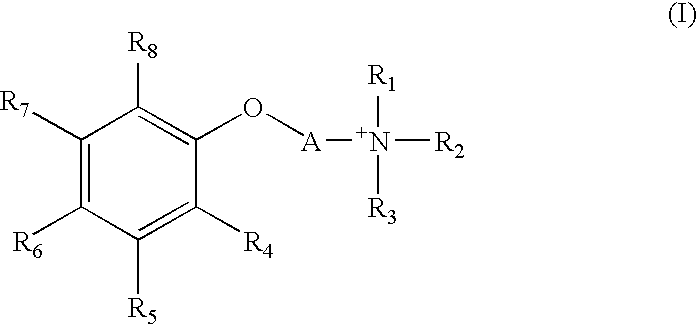Quarternary Ammonium Compound, Process for Producing the Same, Therapeutic Agent for Cerebrovascular Disorder, and Therapeutic Agent for Heart Disease
a technology of quarternary ammonium and compound, which is applied in the direction of biocide, drug composition, extracellular fluid disorder, etc., can solve the problem of unknown compound, and achieve the effect of superior pharmacological
- Summary
- Abstract
- Description
- Claims
- Application Information
AI Technical Summary
Benefits of technology
Problems solved by technology
Method used
Image
Examples
example 1
[2-(4-ethoxycarbonyl-phenoxy)-ethyl]-trimethylammonium p-toluenesulfonate
[0049]25.0 g (0.11 mol) of the ethyl 4-(2-dimethylaminoethoxy)benzoate obtained in Comparative Example 1 were dissolved in 250 mL of methanol in a nitrogen atmosphere. After adding 23.6 g (0.13 mol) of methyl p-toluenesulfonate while stirring at room temperature, the solution was stirred for 2 hours while heating to 50° C. After distilling off the solvent, the resulting residue was recrystallized from a mixed solvent of 100 mL of methanol and 500 mL of ethyl acetate to obtain 35.9 g of the target substance (yield: 81%).
[0050]1H-NMR (300 MHz, DMSO-d6): δ=7.95 (d, 2H, J=6.6 Hz), 7.49 (d, 2H, J=6.3 Hz), 7.10 (m, 4H), 4.54 (m, 2H), 4.29 (q, 2H, J=5.1 Hz), 3.82 (m, 2H), 3.19 (s, 9H), 2.29 (s, 3H), 1.31 (t, 2H, J=5.1 Hz)
[0051]13C-NMR (75.7 MHz, DMSO-d6): δ=165.21, 161.08, 145.73, 137.46, 131.07, 127.93, 125.41, 122.84, 114.62, 63.92, 61.82, 60.32, 53.05, 20.69, 14.13
example 2
Ethyl 3-hydroxy-4-methoxybenzoate
[0052]20.0 g (0.12 mol) of 3-hydroxy-4-methoxybenzoate and 200 mL of tetrahydrofuran were placed in 500 mL four-mouth flask and dissolved. 80 mL (0.57 mol) of triethylamine were added to this solution at room temperature followed by adding 40 mL (0.31 mol) of diethyl sulfate and stirring while heating. After stirring up for 1 hour at 60° C., the reaction mixture was poured into water and the pH was adjusted to 7 with 1 mol / L hydrochloric acid followed by extraction with ethyl acetate. The resulting organic layer was dried with magnesium sulfate followed by filtering out the drying agent and concentrating under reduced pressure. The resulting residue was purified with a silica gel column chromatograph using for the elution solvent a 1:4 mixture of acetone and hexane to obtain 21.1 g of the target substance (yield: 90%).
[0053]1H-NMR (300 MHz, CDCl3): δ=7.62 (m, 2H), 6.86 (d, 1H, J=8.6 Hz), 5.76 (s, 1H), 4.34 (q, 2H, J=7.1 Hz), 3.93 (s, 3H), 1.37 (t, 3H...
example 3
Ethyl 3-(2-dimethylaminoethoxy)-4-hydroxy-benzoate Hydrochloride
[0056]2.67 g (10 mmol) of the ethyl 3-(2-dimethylaminoethoxy)-4-methoxy-benzoate obtained in Comparative Example 2 were dissolved in 53 mL of methylene chloride and cooled to about −80° C. 12 mL (12 mmol) of boron tribromide (1 mol / L methylene chloride solution) were dropped in. The solution was returned to room temperature and allowed to stand overnight. After cooling in a salt / ice bath, 20 mL of water were added followed by neutralizing with 1 mol / L sodium hydroxide. After separating, the organic layer was dried with magnesium sulfate and concentrated. 4 mL of 20% hydrogen chloride-ethanol solution were added to the residue followed by filtering the precipitated crystals and drying to obtain 1.74 g of the target substance (yield: 60%).
[0057]1H-NMR (400 MHz, CD3OD): δ=7.69 (s, 1H), 7.68 (d, 1H, J=8.8 Hz), 6.98 (d, 1H, J=8.8 Hz), 4.46 (t, 2H, J=5.0 Hz), 4.37 Hz), 3.68 (t, 2H, J=5.2 Hz), 3.07 (s, 6H), 1.41 Hz)
[0058]13C-N...
PUM
| Property | Measurement | Unit |
|---|---|---|
| temperature | aaaaa | aaaaa |
| temperature | aaaaa | aaaaa |
| temperature | aaaaa | aaaaa |
Abstract
Description
Claims
Application Information
 Login to View More
Login to View More - R&D
- Intellectual Property
- Life Sciences
- Materials
- Tech Scout
- Unparalleled Data Quality
- Higher Quality Content
- 60% Fewer Hallucinations
Browse by: Latest US Patents, China's latest patents, Technical Efficacy Thesaurus, Application Domain, Technology Topic, Popular Technical Reports.
© 2025 PatSnap. All rights reserved.Legal|Privacy policy|Modern Slavery Act Transparency Statement|Sitemap|About US| Contact US: help@patsnap.com



